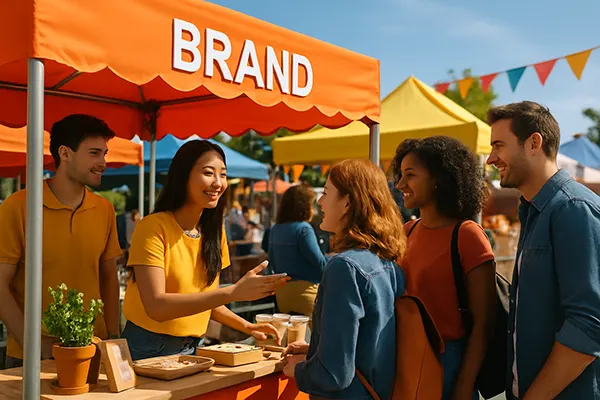
Participating in local fairs and festivals has become a powerful tactic for brands aiming to enhance their visibility and strengthen customer connections. In an era where digital noise overwhelms audiences, face-to-face interactions at physical events offer a refreshing and effective form of engagement. Businesses, both large and small, are rediscovering the value of being physically present in communities, where they can directly connect with potential customers and build brand loyalty.
Strengthening Brand Presence Through Physical Interaction
One of the most impactful benefits of participating in fairs and festivals is the ability to meet consumers face-to-face. While online branding is essential, it often lacks the personal connection that builds lasting loyalty. At events, businesses can communicate their brand values through live demonstrations, direct product trials, and friendly, human interaction. This experience leads to more meaningful relationships and emotional brand recall.
Moreover, the physical setting of fairs and festivals allows for creative and immersive branding opportunities. From customised booths to interactive installations, companies can design unique environments that reflect their identity. This visual and sensory exposure can leave a lasting impression on attendees, increasing the likelihood of future engagement or purchases.
Fairs also allow for immediate feedback. Brands can observe reactions, answer questions in real time, and adjust their communication strategies on the spot. These insights are incredibly valuable and often more genuine than online surveys or analytics tools, which can suffer from selection bias or low response rates.
Building Local Trust and Community Engagement
By participating in regional festivals, companies often become associated with the local culture and community values. This association fosters trust, particularly among consumers who prefer to support businesses that contribute to their immediate environment. A strong local presence can significantly enhance brand reputation and open doors for long-term partnerships.
Involvement in festivals also signals social responsibility. Whether it’s sponsoring a local event or providing eco-friendly products at a fair, these actions demonstrate that a brand is invested in more than just profit. Modern consumers—especially Gen Z and Millennials—are more likely to align themselves with brands that show a commitment to social and environmental causes.
Engagement through fairs can lead to word-of-mouth marketing. Attendees often share their positive experiences through social media, helping to amplify brand recognition beyond the event itself. This organic exposure is not only cost-effective but also perceived as more authentic by audiences.
Leveraging Events for Content Creation and Lead Generation
Fairs and festivals provide a goldmine of content opportunities. From behind-the-scenes footage to customer testimonials, businesses can collect high-quality media that boosts their digital presence. These materials are ideal for social media, newsletters, or even internal branding initiatives. A single event can fuel months of content when leveraged strategically.
Additionally, these events are prime locations for gathering leads. Through competitions, QR code sign-ups, or product sampling in exchange for contact details, companies can collect valuable customer data in a non-intrusive way. When paired with clear consent and transparent data policies, this strategy becomes a reliable funnel for future marketing campaigns.
Another critical advantage is the opportunity to study competitors. Events typically host several brands within a niche, allowing marketers to observe other approaches, pricing strategies, and consumer reactions. This competitive intelligence can inform future campaigns and provide a clearer understanding of market positioning.
Boosting Sales and Driving Immediate Conversions
Fairs are not just about visibility—they can also drive immediate sales. Attendees often come prepared to discover and purchase new products, especially when exclusive deals or event-only promotions are available. This creates a sense of urgency that encourages quicker decision-making.
Having a physical product demonstration on-site increases trust. Seeing how a product works in real-time reduces hesitation and builds confidence in its value. Furthermore, brand ambassadors can respond directly to objections, offer alternatives, or upsell complementary products on the spot.
In addition to on-site purchases, these events can direct traffic to online platforms. Businesses can offer digital discount codes or sign-ups for loyalty programmes, ensuring that the relationship extends beyond the fair and into continued engagement online.

Strategic Planning and Measurement of Event Impact
To maximise the return on investment, participation in fairs and festivals should be planned strategically. This includes setting clear goals—such as lead targets, brand exposure metrics, or direct sales benchmarks—and aligning them with a marketing calendar. Pre-event promotion through social media and email marketing also ensures that attendance translates into meaningful interactions.
Post-event analysis is equally important. Tracking foot traffic, lead conversion rates, and social media mentions helps evaluate the impact and refine future participation. Many brands also send post-event surveys to gather qualitative feedback and understand how their presence was perceived by attendees.
Budget management is a crucial part of planning. Businesses need to consider booth design, staffing, promotional materials, travel, and accommodation costs. Evaluating cost per acquisition after the event allows for data-driven decisions on whether to increase or scale back future involvement.
Long-Term Benefits and Brand Loyalty
Fairs and festivals may seem temporary, but their influence can extend well beyond the event. Attendees who had a positive interaction are more likely to become long-term customers, especially when followed up with timely digital communication. A strong first impression often sets the stage for future engagement.
Participation also contributes to the brand story. Regular appearances at community events position the company as reliable, present, and involved. This consistency reinforces trust and builds a narrative that customers remember when making purchasing decisions.
Lastly, recurring involvement in fairs can create a loyal base of event-specific customers. These individuals look forward to seeing a brand year after year, building anticipation and a sense of brand belonging that’s difficult to achieve through online campaigns alone.
